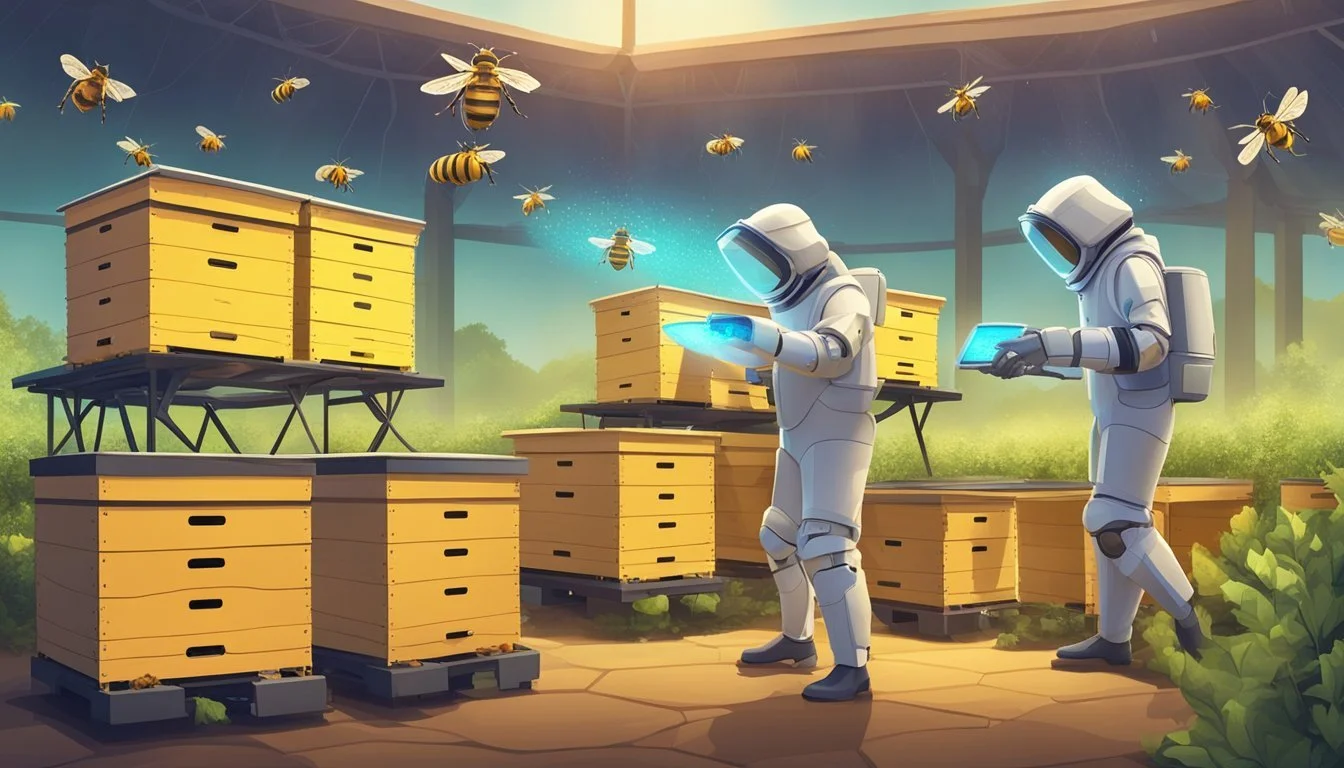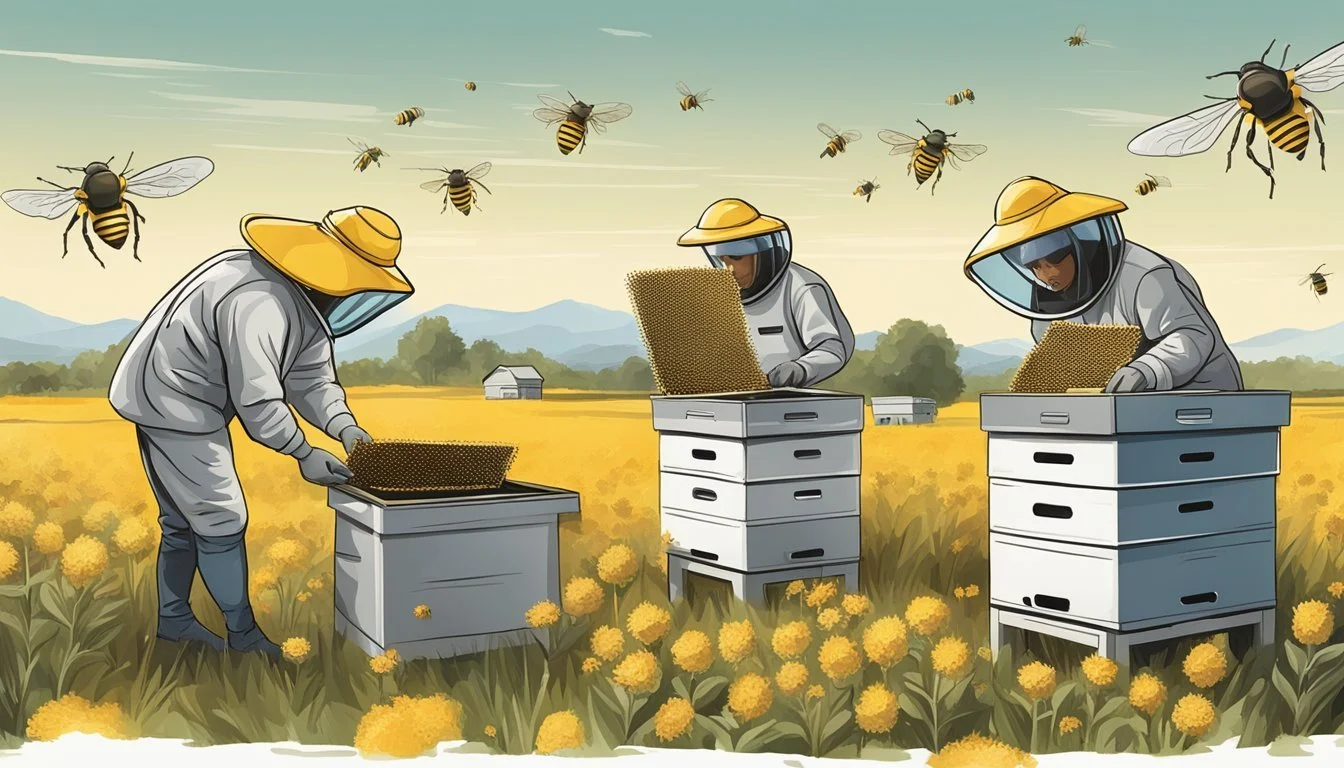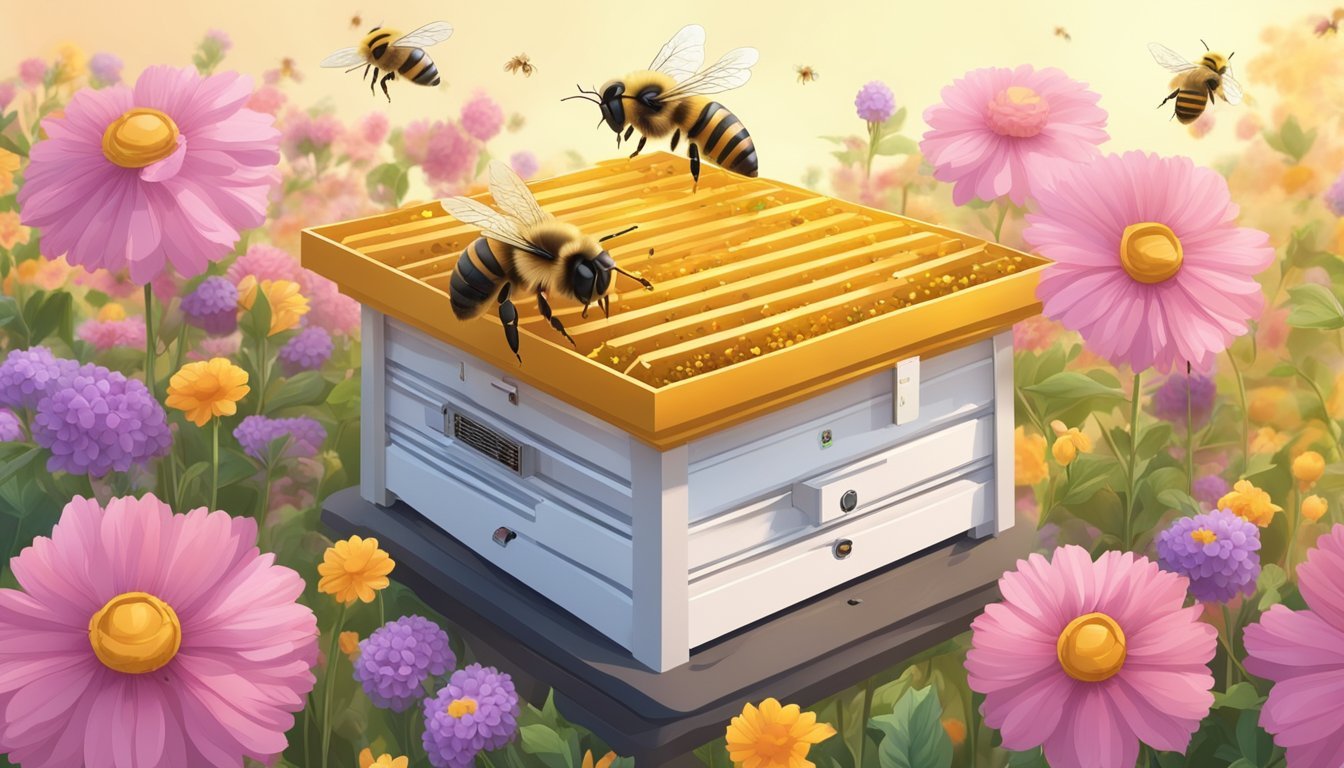The Future of Beekeeping
Embracing Innovation and Sustainable Practices
Beekeeping, an enduring agricultural practice, is at a crucial juncture faced with myriad challenges and presented with numerous opportunities. The industry's vitality hinges on its capacity to navigate adversities such as climate change, habitat loss, and the pervasive threat of colony collapse disorder. Yet, it stands to benefit from a heightened collective consciousness about sustainability and environmental conservation. The global impetus to protect pollinators, integral to the health of ecosystems, is fostering increased interest and support for beekeeping, which in turn is driving demand for bee products and pollination services.
Technological innovation is a beacon of hope, propelling the future of beekeeping into a new era. Advancements such as remote hive monitoring and automated management systems are not only streamlining beekeeping practices but also enhancing the well-being of bee colonies. These technologies enable beekeepers to monitor hive health with precision, intervening promptly to address issues, thus increasing the chances of colony survival and productivity.
As society gravitates towards sustainable agriculture, beekeeping emerges as a key player in the maintenance of food security through its essential role in pollination. This intersection of technology and sustainability hints at a transformative phase for beekeeping, where challenges are met with creative solutions that bolster the industry's resilience and contribute to a healthier environment.
Historical Context of Beekeeping
The Evolution of Apiculture
Beekeeping, or apiculture, has its roots in early human history, and it has evolved considerably over the millennia. Early humans harvested honey (What wine goes well with honey?) from wild bees, which led to the domestication of bees and the development of beekeeping traditions.
Ancient Techniques:
Egyptians were among the first to practice beekeeping by housing bees in cylindrical hives.
Greeks and Romans advanced beekeeping, with writers like Aristotle documenting bee management techniques.
Medieval Europeans adopted straw skeps to house bees, which, while effective, made removing honey without destroying the hive difficult.
Transition to Modern Beekeeping
In the 18th and 19th centuries, beekeeping saw advancements in hive design that allowed for the collection of honey without harming the colony. The invention of the movable-frame hive by Lorenzo Lorraine Langstroth in 1851 was revolutionary, as it permitted beekeepers to extract honey while preserving bees' living quarters.
Adoption of Technology and Science
Beekeeping has not only relied on tradition but also on innovations gained through scientific discovery. With the understanding of bee biology and behavior, new techniques and tools were developed, enhancing productivity and sustainability in beekeeping practices.
Century Advancements 18th Improved hives and beginnings of bee space understanding 19th Creation of the movable-frame hive 20th Motorized extractors, queen-rearing innovations
Continuity and Change
Today, beekeeping rests at the intersection of tradition and innovation, with modern beekeepers integrating time-honored methods with new technologies. This synergy of past and present continues to shape the trajectory of apiculture into the future.
The Role of Bees in Ecosystems
Bees play a crucial role in maintaining healthy ecosystems through their pollinating activities, which support agricultural productivity and biodiversity. However, they face significant challenges from habitat loss and environmental stressors.
Pollination and Biodiversity
Bees are nature's foremost pollinators, transferring pollen from the male to the female components of flowers, a process vital for plant reproduction. Their activity affects a wide variety of plants, including many wildflowers and a substantial number of crop species. This pollination not only leads to the production of seeds and fruits but also promotes genetic diversity within plant populations.
Contributions to biodiversity:
Pollination of over 85% of flowering plants
Enhancement of flora variety in ecosystems
Impact of Honeybees on Agriculture
Honeybees have a direct impact on agriculture, as they are responsible for the pollination of numerous crop species. These include fruits, nuts, and vegetables which make up a significant part of the human diet. In their quest for nectar and pollen, honeybees provide indispensable services that improve crop yields and quality
Key crops pollinated by honeybees:
Apples, almonds, and berries
Crucial for the continued production of these food sources
Habitat Loss and Environmental Stressors
Habitat loss is one of the most pressing issues for bee populations, as development, agriculture, and urbanization encroach on natural areas. Environmental stressors such as pollution, pesticide exposure, and climate change exacerbate these effects, leading to declining bee populations. Preservation of natural habitats and the implementation of bee-friendly practices in agriculture are necessary steps to mitigate these threats.
Environmental challenges facing bees:
Climate change and its impact on flowering times
Pesticide use reducing bee health and survival
Protecting the health and habitats of bees is essential to sustain the ecosystems that humans and wildlife rely on for survival and well-being.
Current Challenges in Beekeeping
Beekeeping faces a multitude of current challenges that directly affect the survival and productivity of bee colonies. These hurdles range from biological threats to environmental pressures.
Pests and Diseases
Pests and diseases remain a significant threat to bee populations. They undermine colony health and can devastate entire hives. Pests such as the small hive beetle and wax moths, alongside diseases like American foulbrood and Nosema, are constant concerns for beekeepers.
Varroa Mite Infestations
The Varroa mite is a predominant pest that poses an acute risk to honeybees. These mites cling onto bees, weaken them by feeding on their bodily fluids, and transmit viruses. Successful management of these infestations is critical for the survival of bee colonies.
Effects of Climate Change
Climate change introduces unpredictable weather patterns, which adversely affect foraging patterns and the availability of nectar and pollen. These changes can lead to malnutrition and reduced resilience of bees against pests and diseases.
Colony Collapse Disorder
Colony Collapse Disorder (CCD), characterized by the sudden disappearance of worker bees, presents a complex challenge, with factors like pests, diseases, stress from management practices, and environmental changes all potentially playing a role.
Chemical Pesticides and Pollution Impact
Exposure to chemical pesticides and pollution compromises bee health and can be lethal. Pesticide contamination affects bees' navigation abilities, immunity, and breeding success, while pollution can degrade the quality of their foraging habitat.
Technological Advances in Beekeeping
As the beekeeping industry evolves, it harnesses sophisticated technologies aimed at improving hive health and productivity. These innovations not only make beekeeping more efficient but also help protect these vital pollinators.
Remote Monitoring and IoT
The advent of Internet of Things (IoT) technologies has enabled beekeepers to remotely track hive conditions in real-time. Remote monitoring systems utilize sensors within hives to relay data on temperature, humidity, and honey production, crucial for preemptive bee health interventions.
In-Hive Sensors and Automated Systems
In-hive sensors collect data on various parameters such as brood temperature, which is key to understanding the developmental state of the hive. Automated systems can regulate the hive environment, performing tasks like climate control to optimize conditions for bee health.
Data-Driven Decisions and Machine Learning
Machine learning algorithms analyze vast datasets collected by in-hive sensors to uncover patterns in bee behavior and health. Beekeepers leverage this data-driven beekeeping approach to make informed decisions, potentially increasing sustainability and yields.
Robotics and Drones Usage
Beekeepers are employing robotics and drones to assist with tasks ranging from pollination to hive inspection. Drones, for instance, can be deployed to survey crops and landscape, finding the best sites for hives, while robots may eventually handle dangerous tasks, reducing the risk to beekeepers.
Improving Bee Health and Hive Management
Advancements in technology have provided beekeepers with powerful tools to enhance bee health and hive management. These innovations are critical in tackling issues related to nutrition, pest and disease management, and genetic diversity.
Nutrition and Feeding Practices
Beekeepers now employ data-driven techniques to optimize bee nutrition, crucial for colony health. Specific tools help in monitoring hive weight and forage availability, guiding beekeepers on optimal feeding times and nutrient requirements. Tailored feeding strategies are developed to ensure hives have access to a balanced diet year-round, which can include supplemental feeds rich in proteins and essential sugars during scarce periods.
Sustainable and Natural Pest Management
Pests pose a serious threat to bee colonies, but modern pest management practices emphasize sustainability and harm minimization. Bio-controls and organic compounds are replacing harsh chemicals, and precision application tools ensure treatments are targeted and efficient. New detection methods, such as AI-powered monitoring systems, can identify pest presence early, allowing for timely intervention without disrupting the bees.
Disease Management and Prevention
Emerging technologies are revolutionizing bee disease management. Remote monitoring devices can detect signs of disease within the hive, triggering alerts for beekeepers. Their use leads to immediate and appropriate responses, thereby preventing outbreaks. Efforts also focus on educating beekeepers on best management practices for hygiene and disease prevention, minimizing antibiotic use and fostering healthier colonies.
Breeding and Genetic Diversity
Genetic diversity is key for resilient bee populations. Bee breeding now uses genetic tools to select for desirable traits, such as disease resistance and productivity. Beekeepers collaborate on breeding programs that maximize genetic diversity and increase the overall vigor of bee populations. Maintaining a rich genetic pool ensures adaptability to changing environments and threats.
Honey Production and Bee Products
The future of beekeeping in honey production showcases a blend of technological advancements and an understanding of bee product diversification, assuring sustainable yields and quality enhancement.
Innovations in Honey Extraction
Technological improvements in honey extraction have streamlined the process, significantly reducing the time and labor traditionally required. Centrifugal extractors have seen advancements in automation and efficiency, allowing for more delicate handling of the combs, which preserves the bees' hard work and minimizes wastage. Additionally, innovations like flow hives offer a non-intrusive method to tap honey directly from the hive without disturbing the bees, leading to a purer and less contaminated product.
Key Points:
Automated centrifugal extractors enhance efficiency and preserve hive structure.
Flow hives enable non-intrusive harvesting, yielding cleaner honey.
Bee Byproducts: Beeswax, Royal Jelly, and Propolis
Bee byproducts have gained attention not only for their traditional uses but also for their potential in various industries.
Beeswax: A natural wax produced by honey bees, beeswax is used in the production of candles, cosmetics, and as a food additive. The demand for organic and sustainable products has led to a rise in beeswax popularity for its environmentally friendly properties.
Royal Jelly: This nutrient-rich substance feeds the queen bee and has been harvested for dietary supplements and in skin care products for its alleged health benefits.
Propolis: A resinous mixture produced by bees, propolis has been used historically for its medicinal properties. It is currently being researched for its potential use in various health products due to its antimicrobial characteristics.
Utilization Table:
Byproduct Use Notes Beeswax Candles, cosmetics, food additive Valued for its versatility and sustainability Royal Jelly Dietary supplements, skin care products Rich in nutrients, under research for extensive health benefits Propolis Medicinal, health products Known for antimicrobial properties, expanding in market demand
These products represent additional revenue streams for beekeepers and contribute to the overall growth of bee populations by incentivizing beekeepers to maintain healthy hives for more than just honey production.
Societal Impact and Consumer Education
The future of beekeeping is not only about technological advancement but also hinges on building societal connections through educational efforts and community engagement to foster a deeper understanding of the vital role bees play in our ecosystems and food supply.
Outreach and Awareness Programs
Outreach and awareness programs play a crucial role in educating consumers about the importance of bees. These programs often include public demonstrations, workshops, and presentations at local markets or fairs. Entities such as non-profit organizations and beekeeping associations collaborate to spread awareness about the threats to bee populations and the impact consumers can have through their purchasing choices and advocacy.
Urban Beekeeping Movement
Urban beekeeping has emerged as a key trend and is influential in enhancing biodiversity in metropolitan areas. City dwellers participate in beekeeping to produce local honey and contribute to local flora pollination. Urban beekeeping initiatives often include the installation of beehives on rooftops and in gardens, accompanied by educational materials to inform residents about the significance of their efforts and best practices for maintaining healthy hives.
Education in Schools and Communities
Education plays a fundamental role in society's efforts to understand and protect bees. Schools around the world are incorporating beekeeping into their curricula, enabling students to observe bees up close and learn about their life cycle and importance to agriculture. Community workshops, led by experienced beekeepers, aim to provide hands-on experience and practical knowledge to aspiring beekeepers, emphasizing the relationship between human actions and the well-being of bee populations.
Future Trends and Beekeeping Industry Outlook
The beekeeping industry is on the cusp of transformation, primed by emerging trends and technological advancements.
Emerging Trends:
Precision Beekeeping: Deploying sensor technology for monitoring hive health.
Collaborative Farming: Shared efforts to improve beekeeping practices.
Circular Food Economy: Integration of by-products into other agricultural sectors.
Technological Advancements:
Hive Inspection Tools: Equip beekeepers with sophisticated sensors and AI to detect diseases and infestations.
Beekeepers now often integrate mobile apiary management systems, leveraging real-time data to make informed decisions about their hives. In precision agriculture, they employ analytic tools to optimize beekeeping conditions, enhancing bee health and productivity. These trends signify a sector in tune with sustainability and efficiency.
Collaborative Farming plays a significant role, as beekeepers form alliances to share resources and knowledge, streamlining their practices and boosting yields. The circular food economy also benefits, as bee-related products find new use in other agricultural domains, creating less waste and increasing sustainability.
In conclusion, the beekeeping industry is adopting a dynamic approach towards a more productive and sustainable future. As it continues to implement innovative solutions, its outlook appears resilient and adaptable to the needs of the ever-changing agricultural landscape.
Leveraging Partnerships and Collaborations
In the evolving landscape of beekeeping, partnerships and collaborations are essential for mutual benefits. They serve as a conduit for sharing best practices and innovations, ensuring that both beekeeping and associated industries thrive.
Working with Farmers and Agriculture Industry
Farmers and the agriculture industry play a pivotal role in beekeeping, with the pollination services of honeybees being critical for many crops. There is a growing trend where beekeepers collaborate closely with farmers to optimize pollination and improve crop yields. Integrated farming practices such as:
Crop rotation to maintain soil health and reduce pests.
Planting bee-friendly flora around crop fields to support bee nutrition.
These practices not only benefit the bees and contribute to their population growth but also enhance the quality and quantity of farm produce.
Community Supported Apiculture
Community supported apiculture (CSA) is a form of collaborative farming where the community and beekeepers work hand in hand. This involves the community in beekeeping efforts and facilitates a shared responsibility for maintaining bee populations. Key initiatives include:
Educational workshops to disseminate knowledge about bees and beekeeping.
Adoption programs where community members sponsor hives and share in the honey harvest.
The community's involvement in beekeeping helps increase awareness about the importance of bees and encourages practices that support bee health. This, in turn, enriches local ecosystems and promotes sustainable living.
Interesting Beekeeping Innovations and Projects
Innovations in beekeeping are transforming the ancient practice with advanced technologies like sensors, robotics, and data analytics to promote hive health and improve yields.
ApisProtect and Smart Hive Technology
ApisProtect is at the forefront of smart hive technology, equipping beekeepers with powerful tools to monitor hive conditions. Their system uses sensors that measure temperature, humidity, CO2 levels, and hive weight to provide real-time data. With this information, beekeepers can make informed decisions to enhance the well-being of their bees and prevent losses.
Pollenity and BeeBots
The company Pollenity is integrating advancements in AI and robotics to innovate the way beekeepers interact with their hives. Their product, BeeBot, represents a significant stride in bee-tech, offering a mobile application that interprets data from sensors placed inside beehives. The app delivers vital insights about the health and productivity of bees directly to a beekeeper's smartphone.
Thermosolar Hives and BeeWeb Platforms
Thermosolar Hive is a groundbreaking development offering a sustainable method to combat parasites, such as Varroa mites, using the power of the sun. The hive's unique design allows it to collect solar heat, which can be regulated to safely eliminate these threats without harmful chemicals. On the digital side, BeeWeb platforms provide online tools and resources that support beekeepers in managing and analyzing the extensive data collected from these innovative hives.
Practical Tips for Hobbyists and Professional Beekeepers
For Hobbyists:
Begin with the basics: Educate oneself on bee behavior and hive management.
Select appropriate hive structures: Traditional vs. modern designs like the top-bar or the Langstroth hive.
Monitoring: Invest in simple hive sensors to track temperature and humidity.
Network: Join local beekeeping clubs to share experiences and learn from others.
For Professionals:
Embrace modern technologies: Utilize advanced monitoring systems for large-scale operations.
Sustainable practices: Implement eco-friendly methods and integrated pest management techniques.
Tools: Ensure high-quality, durable tools for regular hive maintenance and honey extraction.
Industry trends: Stay informed on beekeeping industry changes to adapt and thrive.
Common Essentials:
Aspect Hobbyists Professionals Hive selection Start with a single, manageable hive. Use uniform hives for interchangeability. Monitoring Basic sensors for key indicators. Advanced systems for detailed analytics. Tools Basic toolkit; expand as needed. High-end, efficient tools for scale. Sustainable practices Focus on local flora for forage. Implement practices that ensure a healthy bee population.
Hobbyists and professionals alike should regularly inspect their hives, maintain clear records of their bees' health and activity, and remain vigilant for signs of disease or distress. Using appropriate protective gear, managing hives responsibly, and respecting the bees are cornerstones of both successful hobby and professional beekeeping.







